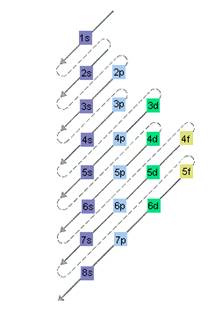
Basic Chemistry
6th Edition
ISBN: 9780134878119
Author: Timberlake, Karen C. , William
Publisher: Pearson,
expand_more
expand_more
format_list_bulleted
Concept explainers
Question
Chapter 5, Problem 112CP
Interpretation Introduction
Interpretation: The reason for which H is placed in group 1A (1) and also in group 7A (17) should be explained.
Concept Introduction: The relative energy of orbitals is represented as follows:

A s orbital can have maximum of 2 electrons, p orbital can have maximum of 6 electrons. Similarly, maximum electrons that a d and f orbital can have are 10 and 14 respectively.
Expert Solution & Answer
Want to see the full answer?
Check out a sample textbook solution
Students have asked these similar questions
Hello, I am doing a court case analysis in my Analytical Chemistry course.
The case is about a dog napping and my role is prosecution of the defendant.
I am tasked in the Area of Expertise in Neutron Activation and Isotopic Analysis.
Attached is the following case study reading of my area of expertise!
The landscaping stone was not particularly distinctive in its decoration but matched both the color and pattern of the Fluential’s landscaping stone as well as the stone in the back of the recovered vehicle. Further analysis of the stone was done using a technique called instrumental neutron activation analysis. (Proceed to Neutron Activation data)
Photo Notes: Landscaping stone recovered in vehicle. Stone at Fluential’s home is similar inappearance.
Finally, the white paint on the brick was analyzed using stable isotope analysis. The brick recovered at the scene had smeared white paint on it. A couple of pieces of brick in the back of the car had white paint on them. They…
Cite the stability criteria of an enamine..
Calculate the pH of a 0.01m solution of acetic acid use pka of 4.75
Chapter 5 Solutions
Basic Chemistry
Ch. 5.1 - What is meant by the wavelength of UV light?Ch. 5.1 - How are the wavelength and frequency of light...Ch. 5.1 - What is the difference between "white” light and...Ch. 5.1 - Prob. 4PPCh. 5.1 - Ultraviolet radiation (UVB) used to treat...Ch. 5.1 - AM radio waves have a frequency of 8105s1, whereas...Ch. 5.1 - If orange light has a wavelength of 6105cm, what...Ch. 5.1 - A wavelength of 850 nm is used for fiber-optic...Ch. 5.1 - Prob. 9PPCh. 5.1 - Prob. 10PP
Ch. 5.1 - Prob. 11PPCh. 5.1 - Place the following types of electromagnetic...Ch. 5.1 - Prob. 13PPCh. 5.1 - Place the following types of electromagnetic...Ch. 5.2 - What feature of an atomic spectrum indicates that...Ch. 5.2 - How can we explain the distinct lines that appear...Ch. 5.2 - Prob. 17PPCh. 5.2 - Prob. 18PPCh. 5.2 - Prob. 19PPCh. 5.2 - Prob. 20PPCh. 5.3 - Describe the shape of each of the following...Ch. 5.3 - Describe the shape of each of the following...Ch. 5.3 - Match statements 1 to 3 with a to d: 1. They have...Ch. 5.3 - Match statements 1 to 3 with a to d: 1. They have...Ch. 5.3 - Prob. 25PPCh. 5.3 - Indicate the number of each in the following: a....Ch. 5.3 - Prob. 27PPCh. 5.3 - Prob. 28PPCh. 5.4 - Compare the terms electron configuration and...Ch. 5.4 - Compare the terms orbital diagram and electron...Ch. 5.4 - Draw the orbital diagram for each of the...Ch. 5.4 - Draw the orbital diagram for each of the...Ch. 5.4 - Prob. 33PPCh. 5.4 - Write the complete electron configuration for each...Ch. 5.4 - Prob. 35PPCh. 5.4 - Prob. 36PPCh. 5.4 - Prob. 37PPCh. 5.4 - Prob. 38PPCh. 5.4 - Prob. 39PPCh. 5.4 - Give the symbol of the element that meets the...Ch. 5.5 - Use the sublevel blocks on the periodic table to...Ch. 5.5 - Use the sublevel blocks on the periodic table to...Ch. 5.5 - Use the sublevel blocks on the periodic table to...Ch. 5.5 - Use the sublevel blocks on the periodic table to...Ch. 5.5 - Prob. 45PPCh. 5.5 - Use the periodic table to give the symbol of the...Ch. 5.5 - Prob. 47PPCh. 5.5 - Use the periodic table lo give the symbol of the...Ch. 5.5 - Prob. 49PPCh. 5.5 - Prob. 50PPCh. 5.6 - What do the group numbers from IA (1) to 8A (18)...Ch. 5.6 - Prob. 52PPCh. 5.6 - Write the group number using both A/B and 1 to 18...Ch. 5.6 - Write the group number using both A/B and 1 to 18...Ch. 5.6 - Write the valence electron configuration for each...Ch. 5.6 - Prob. 56PPCh. 5.6 - Prob. 57PPCh. 5.6 - Indicate the number of valence electrons in each...Ch. 5.6 - Prob. 59PPCh. 5.6 - Prob. 60PPCh. 5.6 - Prob. 61PPCh. 5.6 - Prob. 62PPCh. 5.6 - Prob. 63PPCh. 5.6 - Select the element in each pair with the higher...Ch. 5.6 - Prob. 65PPCh. 5.6 - Prob. 66PPCh. 5.6 - Prob. 67PPCh. 5.6 - Prob. 68PPCh. 5.6 - Prob. 69PPCh. 5.6 - Prob. 70PPCh. 5.6 - Prob. 71PPCh. 5.6 - Prob. 72PPCh. 5.6 - Which statements completed with a to e will be...Ch. 5.6 - Which statements completed with a to e will be...Ch. 5.6 - Prob. 75PPCh. 5.6 - a. What is the atomic number of Te? b. How many...Ch. 5 - The chapter sections to review are shown in...Ch. 5 - Prob. 78UTCCh. 5 - Prob. 79UTCCh. 5 - Prob. 80UTCCh. 5 - The chapter sections to review are shown in...Ch. 5 - The chapter sections to review are shown in...Ch. 5 - The chapter sections to review are shown in...Ch. 5 - Prob. 84UTCCh. 5 - Prob. 85APPCh. 5 - Prob. 86APPCh. 5 - Prob. 87APPCh. 5 - Prob. 88APPCh. 5 - Prob. 89APPCh. 5 - Prob. 90APPCh. 5 - Prob. 91APPCh. 5 - Prob. 92APPCh. 5 - a. How many 3d electrons are in Fe? (5.4) b. How...Ch. 5 - a. How many 4d electrons are in Cd? (5.4) b. How...Ch. 5 - Write the abbreviated electron configuration and...Ch. 5 - Prob. 96APPCh. 5 - What do the elements Ca, Sr, and Ba have in common...Ch. 5 - Prob. 98APPCh. 5 - Prob. 99APPCh. 5 - Name the element that corresponds to each of the...Ch. 5 - Prob. 101APPCh. 5 - Prob. 102APPCh. 5 - Select the more metallic element in each pair....Ch. 5 - Select the more metallic element in each pair....Ch. 5 - Of the elements Na, P, CI, and F, which (5.6) a....Ch. 5 - Of the elements K, Ca, Br, and Kr, which (5.6) a....Ch. 5 - Prob. 107APPCh. 5 - Prob. 108APPCh. 5 - Prob. 109CPCh. 5 - Prob. 110CPCh. 5 - Prob. 111CPCh. 5 - Prob. 112CPCh. 5 - Prob. 113CPCh. 5 - The following problems are related to the topics...Ch. 5 - The following problems are related to the topics...Ch. 5 - The following problems are related to the topics...
Knowledge Booster
Learn more about
Need a deep-dive on the concept behind this application? Look no further. Learn more about this topic, chemistry and related others by exploring similar questions and additional content below.Similar questions
- What is the product of the reaction? F3C. CF3 OMe NaOH / H₂Oarrow_forwardWhat is the product of the reaction? F3C. CF3 OMe NaOH / H₂Oarrow_forwardWhat would you expect to be the major product obtained from the following reaction? Please explain what is happening here. Provide a detailed explanation and a drawing showing how the reaction occurs. The correct answer to this question is V.arrow_forward
- Please answer the question for the reactions, thank youarrow_forwardWhat is the product of the following reaction? Please include a detailed explanation of what is happening in this question. Include a drawing showing how the reagent is reacting with the catalyst to produce the correct product. The correct answer is IV.arrow_forwardPlease complete the reactions, thank youarrow_forward
- Consider the synthesis. What is compound Y? Please explain what is happening in this question. Provide a detailed explanation and a drawing to show how the compound Y creates the product. The correct answer is D.arrow_forwardWhat would be the major product of the following reaction? Please include a detailed explanation of what is happening in this question. Include steps and a drawing to show this reaction proceeds and how the final product is formed. The correct answer is B. I put answer D and I don't really understand what is going on in the question.arrow_forwardWhat is the product of the following reaction? Please explain what is happening in this question. Provide a detailed explanation and a drawing showing how the reagent is reacting with the catalysts to product the correct product. The correct answer is B.arrow_forward
- What is the missing intermediate 1 and the final product 2. Please include a detailed explanation explaining the steps of malonic ester synthesis. Please include drawings of the intermediate and how it occurs and how the final product is former.arrow_forwardWhat would be the reagents and conditions above and below the arrow that will complete the proposed acetoacetic ester synthesis? If it cannot be done efficiently, then I will choose that answer. There could be 2 or 4 reagents involved. Please provide a detailed explanation and drawings showing how it would proceed with the correct reagents.arrow_forwardFor benzene, the ∆H° of vaporization is 30.72 kJ/mol and the ∆S° of vaporization is 86.97 J/mol・K. At 1.00 atm and 228.0 K, what is the ∆G° of vaporization for benzene, in kJ/mol?arrow_forward
arrow_back_ios
SEE MORE QUESTIONS
arrow_forward_ios
Recommended textbooks for you
 ChemistryChemistryISBN:9781305957404Author:Steven S. Zumdahl, Susan A. Zumdahl, Donald J. DeCostePublisher:Cengage Learning
ChemistryChemistryISBN:9781305957404Author:Steven S. Zumdahl, Susan A. Zumdahl, Donald J. DeCostePublisher:Cengage Learning ChemistryChemistryISBN:9781259911156Author:Raymond Chang Dr., Jason Overby ProfessorPublisher:McGraw-Hill Education
ChemistryChemistryISBN:9781259911156Author:Raymond Chang Dr., Jason Overby ProfessorPublisher:McGraw-Hill Education Principles of Instrumental AnalysisChemistryISBN:9781305577213Author:Douglas A. Skoog, F. James Holler, Stanley R. CrouchPublisher:Cengage Learning
Principles of Instrumental AnalysisChemistryISBN:9781305577213Author:Douglas A. Skoog, F. James Holler, Stanley R. CrouchPublisher:Cengage Learning Organic ChemistryChemistryISBN:9780078021558Author:Janice Gorzynski Smith Dr.Publisher:McGraw-Hill Education
Organic ChemistryChemistryISBN:9780078021558Author:Janice Gorzynski Smith Dr.Publisher:McGraw-Hill Education Chemistry: Principles and ReactionsChemistryISBN:9781305079373Author:William L. Masterton, Cecile N. HurleyPublisher:Cengage Learning
Chemistry: Principles and ReactionsChemistryISBN:9781305079373Author:William L. Masterton, Cecile N. HurleyPublisher:Cengage Learning Elementary Principles of Chemical Processes, Bind...ChemistryISBN:9781118431221Author:Richard M. Felder, Ronald W. Rousseau, Lisa G. BullardPublisher:WILEY
Elementary Principles of Chemical Processes, Bind...ChemistryISBN:9781118431221Author:Richard M. Felder, Ronald W. Rousseau, Lisa G. BullardPublisher:WILEY

Chemistry
Chemistry
ISBN:9781305957404
Author:Steven S. Zumdahl, Susan A. Zumdahl, Donald J. DeCoste
Publisher:Cengage Learning

Chemistry
Chemistry
ISBN:9781259911156
Author:Raymond Chang Dr., Jason Overby Professor
Publisher:McGraw-Hill Education

Principles of Instrumental Analysis
Chemistry
ISBN:9781305577213
Author:Douglas A. Skoog, F. James Holler, Stanley R. Crouch
Publisher:Cengage Learning

Organic Chemistry
Chemistry
ISBN:9780078021558
Author:Janice Gorzynski Smith Dr.
Publisher:McGraw-Hill Education

Chemistry: Principles and Reactions
Chemistry
ISBN:9781305079373
Author:William L. Masterton, Cecile N. Hurley
Publisher:Cengage Learning

Elementary Principles of Chemical Processes, Bind...
Chemistry
ISBN:9781118431221
Author:Richard M. Felder, Ronald W. Rousseau, Lisa G. Bullard
Publisher:WILEY
Precipitation Reactions: Crash Course Chemistry #9; Author: Crash Course;https://www.youtube.com/watch?v=IIu16dy3ThI;License: Standard YouTube License, CC-BY